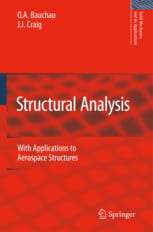 After teaching aerospace structural analysis courses at the advanced undergraduate and graduate levels for more than 30 years, Prof. Bauchau and I published our extensive course notes as a textbook in 2009 (Bauchau, O.A. and Craig, J.I., Structural Analysis-with applications to aerospace structures, Springer, 2009). The book is a full revision and major expansion of course notes developed for students at Georgia Tech over a decade or more. We are currently in the process of collecting feedback and considering creating a second edition.
After teaching aerospace structural analysis courses at the advanced undergraduate and graduate levels for more than 30 years, Prof. Bauchau and I published our extensive course notes as a textbook in 2009 (Bauchau, O.A. and Craig, J.I., Structural Analysis-with applications to aerospace structures, Springer, 2009). The book is a full revision and major expansion of course notes developed for students at Georgia Tech over a decade or more. We are currently in the process of collecting feedback and considering creating a second edition.
The emphasis in the book is on clarity and unity in the presentation of basic structural analysis concepts and methods. The equations of linear elasticity and the basic constitutive behavior of isotropic and composite materials are reviewed. The text focuses on the analysis of practical structural components including bars, beams, and plates. Particular attention is devoted to the analysis of thin-walled beams under bending, shearing, and torsion. Advanced topics such as warping, non-uniform torsion, shear deformations, thermal effect and plastic deformations are addressed. A major feature of the book is a unified treatment of work and energy principles which leads naturally to the introduction of approximate analysis methods including an introduction to matrix and finite element methods. Each chapter contains numerous examples to illustrate theory, and over 330 problems are included.
A current erratum for the book is available below. This provides corrections for all typographic errors detected to date and it also includes clarifications to some of the problems. In addition, a complete set of solutions to all problems is available to legitimate instructors at recognized colleges and universities.
- Errata: the current version (6 Mar 2024) is available here errata6mar24.pdf as a PDF file.
- Homework solutions: a full set of solutions is available on request by email to me (Craig) from instructors at recognized universities. All solutions are worked in Mathematica® and are provided in PDF files. Instructors may also request solutions in Mathematica notebook format.
We are also very interested in hearing your comments on the book and any suggestions for improvements. Please email us at:
- james.craig AT ae.gatech.edu (you must change the AT to @) or
- obauchau AT umd.edu (you must change the AT to @).

